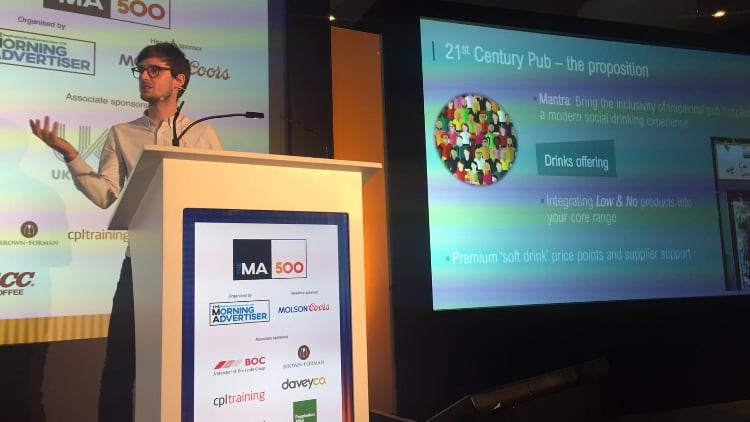Speaking at MA500 London, Hilton explained publicans-cum-peacekeepers faced unique challenges when it comes to conflict resolution in their place of work.
According to research by NFU Mutual, 47% of customers have witnessed some sort of abuse of staff in pubs, with 87,000 violent incidents – or 10% of A&E assault injuries – involving glass.
Moreover, while 60% of diners in the UK have made a complaint in a restaurant, 44% now refrain from doing so for fear of their food being tampered with according to Big Hospitality.
What’s more, close to two thirds (63%) of female respondents have experienced inappropriate sexual behaviour in pubs, clubs and bars according to Big Hospitality, compared to a quarter of men.
“It’s not like being in a factory or an office where the conflict is among colleagues,” Hilton explained. “In hospitality, we have not only the potential for conflict between colleagues, but involving guests.”
The cost of conflict
He continued: “The mental health impact of being on the end of conflict is probably the biggest cost we can think of, but there is a business cost.”
He added that, in addition to 50% of diners expecting money off bill if they complain, businesses can expect to pay on average £500 per employee as a result of absenteeism stemming from workplace conflict.
However, he said it is worth bothering to make things right with customers on the spot given around one in five customers (22%) state that a simple apology suffices when it comes to poor service.
Discussing what he refers to as the guest recovery complex, Hilton stated one should go the extra mile to resolve conflict. “Loyalty builds through the delivery of good service. And even if delivery drops off, as long as we recover that level of service, loyalty can go even higher,” he explained. “Don’t just let conflict walk out the door – there’s an opportunity to turn a dissatisfied guest into a loyal customer.”
How does conflict occur?
When it comes to the opening salvos in on-trade conflict, Hilton states that momentary loss of control can happen to all of us and lead us into a momentary spate of irrational behaviour.
“When you think of what our guests actually invest in – weddings, once-in-a-lifetime occasions, etc – if things don’t go exactly to plan, it can be a trigger.”
What’s more, citing Abraham Maslow’s hierarchy of needs – self-actualisation, esteem, love and belonging, safety and psychological needs – Hilton adds that guests be triggered by anything from rudeness and disappointment with environment, to being ignored, embarrassment, loss of face, fear or being patronised.
Preventing conflict
According to Hilton, avoidance of conflict is more effective than management. “Managing conflict well is clearly positive but if we can avoid it, even better,” he says.
One key piece of advice Hilton stresses can keep customers off the warpath is simply by making sure guests don’t feel like they’re walking into a war zone by successfully managing your pub environment.
He states that making sure a premises isn’t overcrowded and thinking about customer flow is important in preventing conflict. “Not only does overcrowding lead to us taking less money, but the risk of conflict is much higher,” he says. “Get our people to think about the environment will help avoid conflict.”
What’s more, Hilton adds: “Spot body language and don’t just walk past. Avoid escalation where frustration moves into anger moves into violence.”
Take a SAFER approach
Hilton told delegates that a simple acronym, SAFER, has often been an ally in conflict resolution during his experience in the on-trade.
- Step back – “give staff the confidence to step back and work out what’s going on”
- Asses the threat – “make sure decent decision-making takes place. Diving out from behind the bar immediately doesn’t always work”
- Find help – “sometimes the aggressor sees the staff member as being the problem, so switching that person can help to de-escalate. If it’s got to a high escalation level, finding that help could mean contacting the authorities”
- Evaluate options – “assess what are the best options”
- Respond
Communicating effectively
“We can get great communication from words,” Hilton explains. “But it’s actually the congruence between the different things.
“The non-verbal and the tone can detract from what you’re saying. When a team is responding to a situation, we have to make sure they actually mean it and that the cues are right.”
He adds that signalling non-aggression through body language is important because encouraging a disgruntled party can mirror the behaviour of a calm and collected member of staff.
“As one person’s energy gets higher, the other persons can follow suit,” Hilton states. “Our behaviour impacts the attitude of the other person, your attitude can effect their behaviour and the situation changes. It’s about showcasing a calm, collected attitude. That other person should come down to our level.”
Review the situation afterwards
In conclusion, Hilton stressed the importance of reviewing conflict resolution to help shape future strategy and hopefully take preventative action in future.




